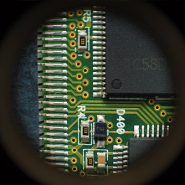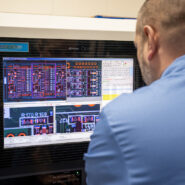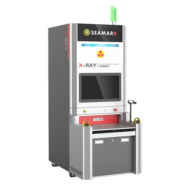
Printed circuit boards (PCBs for short) are the primary component in the majority of electronic devices and appliances. Pretty much anything that has an on/off switch will feature a PCB. In this blog, we will guide you through the steps involved in printed circuit board production, turning a PCB into a PCBA (printed circuit board assembly).
Camtronics doesn’t offer a design service, so this stage is handled by our customers. Once a design is released, the designer will provide a package of data to allow Camtronics to translate the engineer’s work into physical reality.
This data will include, as a minimum, gerber files, PCB specification, and a bill of materials, or BOM. Most will also provide ‘pick-and-place’ data – a file which stipulates the centre point and rotation of each part on the assembly.
The gerbers and PCB specification define the bare board’s size, shape, thickness and pad locations. The BOM tells us what parts are required to assemble the product, and the pick & place data tells us where to put them.
With this data in place, we can get on with the business of PCB assembly.
For the purposes of this blog, we’ll assume all the material is on-hand and that the assembly features surface mount devices.
The most important part of the SMT process. A stainless-steel screen, with a thickness and apertures depending on the component technology on the PCBA, is offered up to the PCB using automated vision alignment of fiducial marks on both items to ensure a precise print. A squeegee then draws a bead of solder paste across the stencil which forces solder paste through the holes and deposits the paste on the PCB pads. The board ‘snaps’ away from the stencil, leaving neat blocks of solder paste in the required locations, and is passed via conveyor to the next stage of the process.
This is the ‘easy’ bit. Parts are placed on the PCB in accordance with the BOM and pick-and-place data, which are combined to generate a machine placement program, at a rate of around 20,000 components per hour with 50-micron accuracy. Devices, which are presented to the machine on trolleys of tubes or reeled tapes, can be as small as 01005 chips, which measure 0.4mm x 0.2mm.
Running a close 2nd to screen printing in the importance stakes, reflow is the stage where the solder paste is melted to physically solder the placed components to the PCB. For each PCBA we make, a bespoke reflow ‘profile’ is generated using a KIC Technology profiler. This matches the thermal demands of the circuit to the heat we apply, ensuring all components are correctly soldered without suffering thermal shock or excess peak temperatures. During this process, the flux in the solder paste is activated to clean the metal surfaces before the paste moves to its liquidous state at the higher temperatures, to create what you’d recognise as solder joints.
Surface-mount assemblies are inspected using an Automated Optical Inspection (AOI) which inspects the solder joints and components on the PCB. Hundreds of inspections per minute are conducted on each PCBA. These include component identification, placement accuracy, orientation and solder fillet inspection using an RGB lighting system.
Any PCBs not conforming to IPC acceptability standards are identified and segregated. If rework is required, the rework technician is able to access the defect details by scanning the barcode fitted to each PCBA.
Inspection is an important part of the printed circuit board production process. In addition to AOI, we maintain a complementary manual inspection stage for a more subjective overview of a circuit, such as looking at the solder finish and general aesthetics of the PCBA.
Our experienced team of inspectors at Camtronics carry out PCBA inspections and visual checks to IPC-610 standards.
Following SMT assembly and inspection, PCBAs are passed to the Conventional Assembly process for the addition on pin-through-hole (PTH) parts, if required. These parts can be soldered by hand, or by wave soldering if appropriate. After a further inspection stage, PCBAs can move to functional test, mechanical assembly (also known as box build), conformal coating or despatch, depending on customer requirements.
We are experts in high-quality printed circuit board production. Our experienced purchasing team can source PCB materials and from across the globe to provide you with the optimal solution to your requirements.
With Camtronics as your manufacturing partner, you can concentrate on your business and leave the PCB assembly to ISO9001 certified experts. Contact us online or over the phone to see how we can help.
Read more
Surface-Mount Technology (SMT) is a manufacturing method most popularly used to create printed circuit boards (PCBs), the foundation of most modern electronics. SMT allows these boards to be built quickly, to exact specifications, en-masse; all whilst complying with regulations.
But SMT needs to be completed with state-of-the-art processes, headed by teams of skilled manufacturers to ensure the end product is completed to a high standard.
At Camtronics, we have provided high-quality manufacturing services for over 25 years. Read on, and we will discuss why expertise like ours matters in the creation of high quality PCBs.
Expert electronics manufacturers over the years learn to implement efficient production processes and streamlined workflows, harnessing their knowledge of SMT technology to enhance assembly speed in ways that do not sacrifice the end quality of the product. We source quality materials and components, to ensure smooth production from start to finish.
No PCBs are made and used equally, that is because they are used in a whole range of applications, from fighter planes to smart fridges. Some may experience high temperatures during operation, some may be subjected to increased wear and tear. This requires modifications to the design to ensure the circuit boards last long, are reliable, and make a more dependable end product.
As experts in surface-mounting, Camtronics can advise on these potential challenges, and means to address them. Whether that is using a different substrate formulation, or distributing the components in another layout. With expertise, clients can avoid costly oversights that result in an unreliable end product.
While automation handles the majority of the PCB manufacturing process, quality control requires input from experts who know what defects to look for. Production errors have to be detected quickly and consistently in the manufacturing process to minimise downtime and wasted resources.
At Camtronics, our qualified technicians make use of X-ray and automated optical inspections, integrated naturally into the manufacturing process. Their skills are employed throughout manufacturing to ensure no substandard PCBs are shipped.
Looking for a trusted PCB manufacturing partner? With over 25 years of experience, there are few companies as knowledgeable as ours. Speak to our experts today and ensure your PCB assembly is in the right hands.
Read more
The availability of accurate inventory levels is an important consideration for all manufacturers.
Do we have sufficient stock? Do we need to buy? If so, how many?
MRP in isolation only goes so far (and let’s not get into spreadsheets). This will provide a calculated number associated with any given part number but will not legislate for any production losses associated with machine setup or a runtime issue, for example.
As a result, physically counting stock back in from production allows the MRP to always reflect accurate stock levels, meaning that future purchases are precise, unplanned production stoppages are avoided, and accounts reporting is complete.
To assist this activity, we have recently taken delivery of a Seamark XC1000 X-ray component counter.
Counting a single reel used to take 3-4 minutes using a traditional counter. This system allows the counting of up to four 7” reels in around 12 seconds. In addition to this speed upgrade, the system automatically prints a label detailing the quantity of the parts on the reel. 13” reels are counted singly.
The system is equally capable of counting tubed and trayed devices, and even bulk parts in a bag, so long as they are on a single ‘layer’.
Additionally, we are able to ‘see through’ bags to confirm supplied quantities prior to opening the packaging. This can be useful if we have been supplied with cut strips, for example.
When Camtronics receives a free-issue kit, we have always checked the supplied quantities physically match those advised, to prevent production stoppages. Frequently, unexpected shortages are identified at this stage, usually because someone believed, “what it said on the reel”. The throughput boost provided by the Seamark allows us to provide feedback to our customer quicker than ever before, allowing them the maximum possible time to order the part, if necessary, and satisfy the shortage so delivery of the finished assembly is not delayed.
For procured items, which carry our in-house lot numbers embedded in a barcode, we are able to scan the counted part and the resulting label shows our internal part number in addition to the count quantity. When counting four reels at a time, the system detects which reel has been picked up after the count process and prints the label for that part in isolation, preventing labelling errors.
The introduction of the Seamark XC1000 has dramatically reduced the amount of (frankly, mundane) time spent counting items in stores, allowing that time to be redeployed on more interesting and value adding activities, whilst improving count accuracy to 99.9%.
In the words of our Stores Supervisor, “I absolutely love it”.
Discover how Camtronics can help your business flourish with our experienced team of engineers and electronics specialists. Contact us today at 01495 717222 for more information about EMS services.
Read more“We have enjoyed an excellent commercial and technical relationship for 20 years with Camtronics. They have supported us in manufacturing and in continuously developing competitive products that keep us at the forefront of the industrial and automotive industry.”
Global industrial sensor & control company
“Throughout our ten-year partnership, we have always valued Camtronics’ commitment to flexibility and communication.
Their collaborative and proactive approach is a major benefit to us and we value the high quality of the increasing number of products they manufacture on our behalf”
Leading UK bio-pharma company
“Camtronics have handled small, one-off panel sample orders right through to large scale production volume orders … and deliveries have always been met.
Communication is a key aspect for us and we have entered into a strong working relationship, one that will hopefully last for a long time.”
Market leading industrial processing company
“Keep up the good work.”
UK based environmental science company
“We love you guys!”
Innovative data logger manufacturer